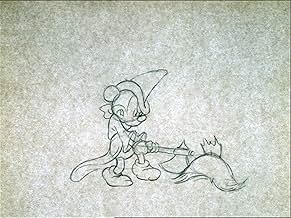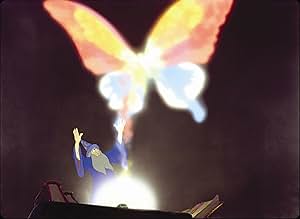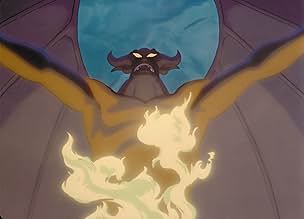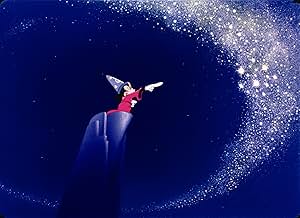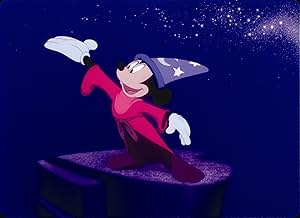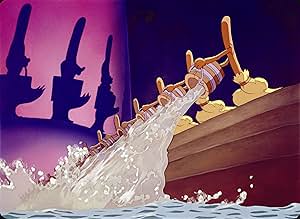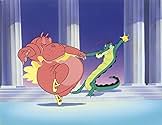AVALIAÇÃO DA IMDb
7,7/10
109 mil
SUA AVALIAÇÃO
A integração das grandes obras da música clássica com visuais extremamente criativos e originais da animação.A integração das grandes obras da música clássica com visuais extremamente criativos e originais da animação.A integração das grandes obras da música clássica com visuais extremamente criativos e originais da animação.
- Prêmios
- 9 vitórias e 1 indicação no total
Corey Burton
- Narrator: Deems Taylor overdubs (2000 restoration)
- (narração)
- (não creditado)
Walt Disney
- Mickey Mouse (segment 'The Sorcerer's Apprentice')
- (narração)
- (não creditado)
Hugh Douglas
- Narrator (1982 version)
- (narração)
- (não creditado)
James MacDonald
- Percussionist
- (não creditado)
Tim Matheson
- Narrator (1985 version)
- (narração)
- (não creditado)
Julietta Novis
- Soloist (segment 'Ave Maria')
- (canto)
- (não creditado)
Paul J. Smith
- Violinist
- (não creditado)
Avaliações em destaque
This is one of the truly rare, one of a kind movie going experiences, kind of in the same league as watching 2001: A Space Odyssey. I like to watch this film repeatedly; often times I'll just close my eyes and daydream, letting my own imagination go in place of whats on the screen. My favorite part is the opening sequence, with its dramatic music and free flowing imagery foreshadowing the state of the world in 1940. The end of Ave Maria is the perfect bookend to this masterpiece; death has withdrawn and peace has finally arrived. It would, but not for another five years and millions of lives. I can never watch this movie without seeing it in this context; for me its a work of art, both a part and ahead of its time.
This unusual and very creative classic of animation combines a very interesting idea with quite a bit of imagination, plus visual effects that still hold up quite well. All but a couple of the sequences are quite enjoyable, and some especially so. Even the segments that don't work as well are usually at least interesting, since you can at least appreciate what they were trying to accomplish.
You don't really have to be all that familiar with the specific pieces of music for it to be worthwhile, since in several cases they chose to match the music with material that is rather different in nature from any original context that it may have had. And in any case, the animated sequences are intended to provide the context, in terms of the movie.
No doubt, everyone will have his or her own favorite segments, based on the music itself and on the choice of accompanying visual material. The "Sorcerer's Apprentice" sequence, with Mickey Mouse, is certainly one of the most memorable. The adaptation of "The Rite of Spring" is quite imaginative in using an entirely different setting for the music. "Night on Bald Mountain" has striking and sometimes bizarre visuals.
Many of the classic Disney features still hold up well as family entertainment, but "Fantasia" is unique for its combination of imaginative concept and visual creativity. Not every minute of it works, but that's the price of being willing to experiment. It's an enjoyable and satisfying feature that well deserves to be remembered.
You don't really have to be all that familiar with the specific pieces of music for it to be worthwhile, since in several cases they chose to match the music with material that is rather different in nature from any original context that it may have had. And in any case, the animated sequences are intended to provide the context, in terms of the movie.
No doubt, everyone will have his or her own favorite segments, based on the music itself and on the choice of accompanying visual material. The "Sorcerer's Apprentice" sequence, with Mickey Mouse, is certainly one of the most memorable. The adaptation of "The Rite of Spring" is quite imaginative in using an entirely different setting for the music. "Night on Bald Mountain" has striking and sometimes bizarre visuals.
Many of the classic Disney features still hold up well as family entertainment, but "Fantasia" is unique for its combination of imaginative concept and visual creativity. Not every minute of it works, but that's the price of being willing to experiment. It's an enjoyable and satisfying feature that well deserves to be remembered.
10Spleen
There cannot be one verdict on "Fantasia". There must be eight: one for each of the seven segments, and an eighth for the film as a whole - for, varied though the seven segments are, they undeniably belong together. And, alas, space does not permit me to lay out all eight verdicts. I shall have to confine myself to details representative of the whole. At any rate, I shall try.
We learn the modus operandi of "Fantasia", the linking theme, in the second segment - an abridged version of Tchaikovsky's "Nutcracker" suite. (Missing are the overture and the march.) Tchaikovsky's ballet involves anthropomorphising inanimate things, plus the odd tiny animal. So does Disney's "Nutcracker". But Disney has thrown out the particular details. The Chinese Dance is danced by mushrooms (who look, but are not, Chinese); the Arabian Dance by "Arabian" goldfish; the Russian dance by "Russian" thistles and orchids. Sometimes it goes further: "Waltz of the Flowers" shows two entire changes of seasons, with leaves, fairies, seed pods, seeds, snowflakes - everything but flowers. But in ignoring the letter of the instructions Disney is perfectly true to the spirit. Indeed he is more true to the spirit than the original ballet - for, let's face it: stage ballet is a degenerate and over-formalised art, which makes some of the world's most exciting music dull as wallpaper. Disney's amazing images express Tchaikovsky's sense of motion more than earthbound dancers ever could. This, one feels, is the kind of thing ballet music was TRULY designed for. The same goes to a lesser extent for the other two pieces of ballet music on the program.
This basic device - ignoring explicit instructions, but remaining true to the spirit - is carried through into every segment. (Some segments are better than others, but none can be called a failure.) Dukas's "The Sorcerer's Apprentice" has been turned into a Mickey Mouse cartoon - but it's the best Mickey Mouse cartoon ever made; and we realise that the story of the Sorcerer's Apprentice is really the archetype that all of the best Mickey Mouse cartoons had been reaching towards, all along. The Pastoral Symphony adheres to Beethoven's program but moves everything from the woods of Central Europe to a dreamland from classical mythology. (The second movement - the section with the courting centaurs - is a failure. For once the spirit as well as the letter of Beethoven is ignored. Unfortunately some critics cannot see beyond this movement to the superb interpretations that flank it on either side.)
I doubt that so much genuine creative work has gone into a film, before or since - even if you don't count the contributions made by the composers. What's my favourite film? I really don't know. But if you tell me that I must sit in a large dark cinema for two hours; and ask me what I would like to occupy my eyes and ears over those two hours, I would answer, without hesitation, Fantasia.
We learn the modus operandi of "Fantasia", the linking theme, in the second segment - an abridged version of Tchaikovsky's "Nutcracker" suite. (Missing are the overture and the march.) Tchaikovsky's ballet involves anthropomorphising inanimate things, plus the odd tiny animal. So does Disney's "Nutcracker". But Disney has thrown out the particular details. The Chinese Dance is danced by mushrooms (who look, but are not, Chinese); the Arabian Dance by "Arabian" goldfish; the Russian dance by "Russian" thistles and orchids. Sometimes it goes further: "Waltz of the Flowers" shows two entire changes of seasons, with leaves, fairies, seed pods, seeds, snowflakes - everything but flowers. But in ignoring the letter of the instructions Disney is perfectly true to the spirit. Indeed he is more true to the spirit than the original ballet - for, let's face it: stage ballet is a degenerate and over-formalised art, which makes some of the world's most exciting music dull as wallpaper. Disney's amazing images express Tchaikovsky's sense of motion more than earthbound dancers ever could. This, one feels, is the kind of thing ballet music was TRULY designed for. The same goes to a lesser extent for the other two pieces of ballet music on the program.
This basic device - ignoring explicit instructions, but remaining true to the spirit - is carried through into every segment. (Some segments are better than others, but none can be called a failure.) Dukas's "The Sorcerer's Apprentice" has been turned into a Mickey Mouse cartoon - but it's the best Mickey Mouse cartoon ever made; and we realise that the story of the Sorcerer's Apprentice is really the archetype that all of the best Mickey Mouse cartoons had been reaching towards, all along. The Pastoral Symphony adheres to Beethoven's program but moves everything from the woods of Central Europe to a dreamland from classical mythology. (The second movement - the section with the courting centaurs - is a failure. For once the spirit as well as the letter of Beethoven is ignored. Unfortunately some critics cannot see beyond this movement to the superb interpretations that flank it on either side.)
I doubt that so much genuine creative work has gone into a film, before or since - even if you don't count the contributions made by the composers. What's my favourite film? I really don't know. But if you tell me that I must sit in a large dark cinema for two hours; and ask me what I would like to occupy my eyes and ears over those two hours, I would answer, without hesitation, Fantasia.
This without a doubt the greatest animated film in history. While highly acclaimed and well-known today, it was not terribly popular when it was first released. The idea of "Fantasia" is to take great pieces of music and draw animated sequences that match them. In doing so, it reverses the purpose of a movie's score; the movie serves and matches the music, not the other way around. This set up also means that there is no typical formula plot that is present in the vast majority of movies. In the first piece, the animation is vague and abstract, but in later ones it is of definite actions, objects, and stories. The two most famous(and my favorite) parts are probably "The Sorcerer's Apprentice" and "Rite of Spring". "Fantasia" is not only the best animated film ever made, but one of the greatest films period.
Fantasia was to be the crowning achievement of Walt Disney Studios, their magnum opus, a work of art that finally convinced the people that animated films could be more than "mere" children's entertainment. Unfortunately, it was too much too soon. People went in expecting children's entertainment - after all, that's what Disney was known for - and instead were treated to high art. Nothing wrong with that, but you need to expect it first. And thus, Fantasia flopped financially, and what was meant to be a continuing series of films, remained just one until the turn of the century.
But oh what a film it is. Music by the best classical composers ever lived, performed by the Philadelphia Orchestra, hosted by Deems Taylor, featuring some the finest animated segments Disney had ever done. It's a stone cold classic, was from the very first moment, and it's a shame it didn't do so well. Luckily it has gone down in history as one of Disney's finest and will be watched and appreciated for centuries to come.
As for the individual segments, they're not of equal quality, though they are all very good in their own ways.
The opening segment, Toccata and Fugue in D Minor, is not one of my personal favourites, but it works as a good opening intro to the idea behind Fantasia and is pretty to look at in its own way. It hasn't aged as well as some of the other segments, but it does its job more than adequately.
Nutcracker Suite, on the other hand, is fantastic. Beautiful images, perfectly accompanied by one of the most recognizable pieces of music there is. After seeing this segment once, it's hard not to see fairies and seasons dancing around whenever you hear the piece.
And then there's The Sorcerer's Apprentice. Everyone knows this one and has most probably seen it, even if they haven't seen the whole film. It's the segment with the most story and is one of the strongest Mickey Mouse shorts ever made. Grandeur, funny and even a bit threatening, it's probably the film's strongest moment.
Rite of Spring is another one with a story, this time about the history of our small blue orb floating in the space. It's intriguing to watch, but once again the animation shows a bit of its age and it's perhaps even a little bit too ambitious for its running length. Not the strongest segment, but once again very good nonetheless.
The Pastoral Symphony and Dance of the Hours, the next two segment, are to me very similar and while they're both fine, I cannot admit to liking them all that much. They're mostly just general gallivanting and while that's fine and fits the music, it can become a bit boring. The Pastoral Symphony is also the segments that has aged the least gracefully with some really rough character designs.
Luckily we have Night on Bald Mountain and Awe Maria to close the film. And they are awe-inspiring. The devil on his lone mountain top is one of the scariest images Disney has ever produced and the rest of the segment is equally haunting, eerie and threatening. Which is why the following tranquility and quietness of Awe Maria works so well and allows you to drift over the finish line with a smile on your face and peace in your heart.
Fantasia is not a perfect film, but it's still one of the finest pieces of art I've ever seen and a perfect introduction to animated films meant for adults. As a child I found it slightly boring. As an adult I'm in awe.
But oh what a film it is. Music by the best classical composers ever lived, performed by the Philadelphia Orchestra, hosted by Deems Taylor, featuring some the finest animated segments Disney had ever done. It's a stone cold classic, was from the very first moment, and it's a shame it didn't do so well. Luckily it has gone down in history as one of Disney's finest and will be watched and appreciated for centuries to come.
As for the individual segments, they're not of equal quality, though they are all very good in their own ways.
The opening segment, Toccata and Fugue in D Minor, is not one of my personal favourites, but it works as a good opening intro to the idea behind Fantasia and is pretty to look at in its own way. It hasn't aged as well as some of the other segments, but it does its job more than adequately.
Nutcracker Suite, on the other hand, is fantastic. Beautiful images, perfectly accompanied by one of the most recognizable pieces of music there is. After seeing this segment once, it's hard not to see fairies and seasons dancing around whenever you hear the piece.
And then there's The Sorcerer's Apprentice. Everyone knows this one and has most probably seen it, even if they haven't seen the whole film. It's the segment with the most story and is one of the strongest Mickey Mouse shorts ever made. Grandeur, funny and even a bit threatening, it's probably the film's strongest moment.
Rite of Spring is another one with a story, this time about the history of our small blue orb floating in the space. It's intriguing to watch, but once again the animation shows a bit of its age and it's perhaps even a little bit too ambitious for its running length. Not the strongest segment, but once again very good nonetheless.
The Pastoral Symphony and Dance of the Hours, the next two segment, are to me very similar and while they're both fine, I cannot admit to liking them all that much. They're mostly just general gallivanting and while that's fine and fits the music, it can become a bit boring. The Pastoral Symphony is also the segments that has aged the least gracefully with some really rough character designs.
Luckily we have Night on Bald Mountain and Awe Maria to close the film. And they are awe-inspiring. The devil on his lone mountain top is one of the scariest images Disney has ever produced and the rest of the segment is equally haunting, eerie and threatening. Which is why the following tranquility and quietness of Awe Maria works so well and allows you to drift over the finish line with a smile on your face and peace in your heart.
Fantasia is not a perfect film, but it's still one of the finest pieces of art I've ever seen and a perfect introduction to animated films meant for adults. As a child I found it slightly boring. As an adult I'm in awe.
Você sabia?
- CuriosidadesDuring production, the animators were given no instructions for coloring. Walt Disney instructed them to use any colors they wanted, which was a first.
- Erros de gravaçãoWhen introducing the "Pastoral" sequence, Deems Taylor mixes Greek and Roman names of deities: Bacchus, Vulcan and Diana are Roman; Zeus, Iris and Morpheus are Greek. Apollo is the only one whose Greek and Roman equivalents have the same name.
- Citações
Mickey Mouse: [Pulling on Stokowski's coat] Mr. Stokowski! Mr. Stokowski!
[Mickey whistles to get Stokowski's attention]
Mickey Mouse: My congratulations, sir!
Leopold Stokowski: [shaking hands with Mickey] Congratulations to you, Mickey!
Mickey Mouse: Gee, thanks! Hehe! Well, so long! I'll be seeing ya!
Leopold Stokowski: Goodbye!
- Cenas durante ou pós-créditosThere are no closing credits of any kind. Not even the words "THE END" appear on the screen.
- Versões alternativasBefore the 1990 re-release, the film was shown with no credits other than the title and the RKO logo. Leopold Stokowski received a written credit only on the posters advertising the film. In the film's original roadshow release, not even the title was shown at the beginning of the film - that was saved for the intermission break.
- ConexõesEdited into A World Is Born (1955)
- Trilhas sonorasToccata and Fugue in D Minor, BWV 565
Composed by Johann Sebastian Bach
Orchestrated by Leopold Stokowski (uncredited)
Played by The Philadelphia Orchestra
Conducted by Leopold Stokowski
Principais escolhas
Faça login para avaliar e ver a lista de recomendações personalizadas
Detalhes
- Data de lançamento
- País de origem
- Central de atendimento oficial
- Idioma
- Também conhecido como
- Fantasía
- Locações de filme
- Empresas de produção
- Consulte mais créditos da empresa na IMDbPro
Bilheteria
- Orçamento
- US$ 2.280.000 (estimativa)
- Faturamento bruto nos EUA e Canadá
- US$ 76.408.097
- Fim de semana de estreia nos EUA e Canadá
- US$ 980.798
- 10 de fev. de 1985
- Faturamento bruto mundial
- US$ 76.414.517
- Tempo de duração2 horas 4 minutos
- Cor
- Mixagem de som
- Proporção
- 1.37 : 1
Contribua para esta página
Sugerir uma alteração ou adicionar conteúdo ausente






